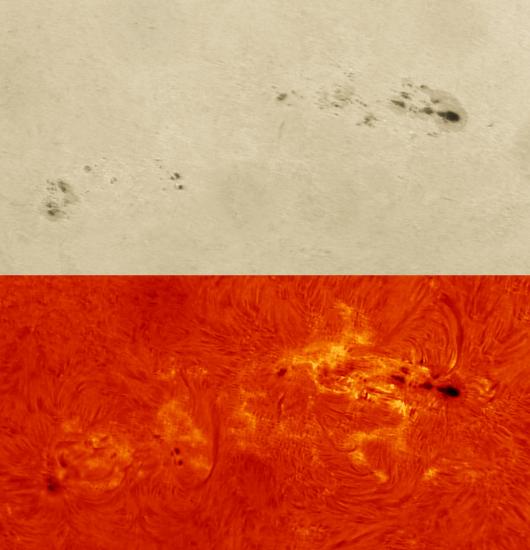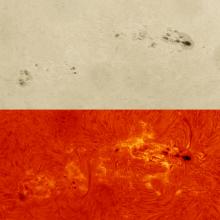A Large, Active Sunspot - July 7, 2013
-
At the Phoebe Waterman Haas Public Observatory in Washington, DC, visitors have been observing fireworks on the Sun over the last several days.
This close-up view, taken on July 7, 2013 at 11:00 am EDT, shows a large, active sunspot group. It is named AR1785. The top panel shows the surface of the Sun, which is the best way to see sunspots in detail. AR1785 is the complex area to the upper right. It extends more than 11 times as wide as the Earth. Other sunspots can be seen to the lower left.
The lower panel shows the same area, in an exact color of red light that reveals the atmosphere of the Sun. Bright clouds of gas, called plages, are suspended above the sunspots by intense magnetic activity. Magnetic arches above the Sun also serve as highways for loops of slightly cooler gas, which appear here as dark lines called filaments.
This sunspot group has been crackling with solar flares. When a flare occurs, it can heat up the plages, making them glow brightly for a few minutes. Visitors to the Observatory have been watching the sunspot group as it slowly moves with the Sun's rotation. On July 4, visitors observed a solar flare.
We plan to keep a close eye on this sunspot group as it continues to rotate across the visible side of the Sun for the next several days.
Telescope: Lunt 100mm hydrogen-alpha with 2x Barlow
Camera: Lumenera SKYnyx 2-2M
Created:
July 07, 2013Photographer:
Geneviève de MessièresID#:
WEB13057-2013Source:
Smithsonian Public Observatory ProjectCopyright:
Smithsonian InstitutionRights Usage:
Contact Smithsonian InstitutionTerms of Use:
Smithsonian Terms of UseFor print or commercial use please see permissions information.

